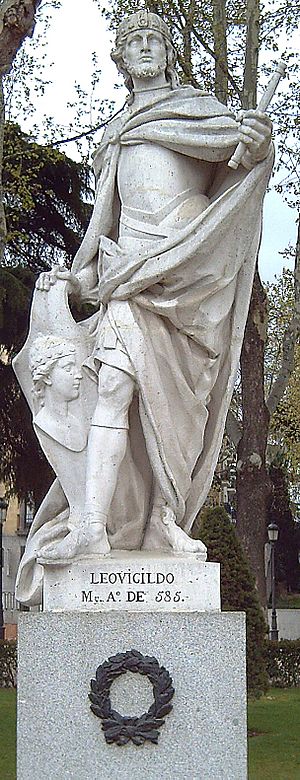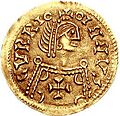Liuvigild facts for kids
Quick facts for kids Liuvigild |
|||||
|---|---|---|---|---|---|

Imaginary portrait by Juan de Barroeta (1854)
|
|||||
| King of Hispania | |||||
| Reign | 569 – 21 April 586 | ||||
| Predecessor | Liuva I | ||||
| Successor | Reccared I | ||||
| Co-king | Liuva I (568–572) | ||||
| Born | c. 519 AD Hispania |
||||
| Died | 21 April 586 Toledo, Hispania |
||||
| Spouse | Theodosia Goiswintha |
||||
| Issue | Reccared I Saint Hermenegild |
||||
|
|||||
| Religion | Arianism | ||||
Liuvigild (born around 519, died 586) was a powerful Visigothic king. He ruled over Hispania (modern Spain and Portugal) and Septimania (part of modern France) from 569 to 586. He is remembered for his new laws, called the Code of Leovigild, which gave equal rights to both Visigoths and the local Hispano-Roman people.
Liuvigild's kingdom covered most of modern Spain and Portugal. He is known as one of the greatest Visigothic kings of his time. He was an Arian Christian, which was the main religion of the Visigothic rulers back then.
Contents
Becoming King and Early Rule
When the Visigothic king Athanagild died in 567, Liuva I became the new king. He was crowned in Narbonne. King Liuva I saw that his younger brother, Liuvigild, was a strong leader. So, in his second year as king, Liuva I made Liuvigild a co-king and his heir.
Liuvigild was given control over the eastern part of Hispania. Both brothers were Arian Christians. This was the main religion for Visigothic rulers until 587.
Liuvigild was married twice. His first wife was Theodosia, and they had two sons, Hermenegild and Reccared I. After Theodosia died, Liuvigild married Goiswintha, who was Athanagild's widow.
Expanding the Visigothic Kingdom
Almost every year of his rule, Liuvigild led military campaigns. He fought against the Byzantines, the Suebi, the Basques, and other groups who challenged his power. A historian named John of Biclaro wrote that Liuvigild had many "striking successes."
Liuvigild's first campaign was against the Suebi in 569. He quickly took control of Zamora, Palencia, and Leon. In 570, he attacked the Bastetania region and defeated the imperial forces there. He also captured Málaga. The next year, he took Medina Sidonia.
Around 571-573, his brother Liuva died, and Liuvigild became the sole ruler. He then took Córdoba from the Byzantine Empire. Even though he often fought the Byzantines, Liuvigild admired their style. He adopted their grand ceremonies, used the title Flavius, and used a throne, crown, scepter, and purple robe. He even made gold coins with his own name on them.
In 573, the Suebi tried to get revenge and invaded some regions. While preparing to fight them, Liuvigild learned his brother Liuva had died. This made him the sole ruler of the entire Visigothic kingdom. To make sure there was a peaceful transfer of power later, Liuvigild made his two sons, Hermenegild and Reccared, co-rulers with him. He made them dukes over important cities like Toledo and Narbonne.
Laws and Unification Efforts
The Visigoths were a military group, and kings needed approval from the nobles. Visigoths and the local Ibero-Roman people were still separate by religion and laws. Liuvigild changed the old laws and created his own set, called the Codex Revisus.
He also got rid of old Roman laws that stopped Visigoths and Ibero-Romans from marrying each other. Before, such marriages could even be punished by death. By doing this and other things, Liuvigild made his rule stronger. After securing his capital, he started new campaigns. He conquered more areas along the Suebian border, like Sabaria and Braganza.
Some people, like Gregory of Tours, thought Liuvigild went too far by dividing the kingdom between his sons. However, he might have done this to reduce the power of the nobles. This action led to several revolts. There were uprisings among the Cantabri, in Cordova and Asturia, and in Toledo and Evora. At the same time, the Suebi and Byzantines were planning attacks.
But Liuvigild was not stopped by these threats. With his son Reccared's help, he put down all the rebellions. He captured Ammaia, the capital of the Cantabri, and the Asturian stronghold of Saldana. He also stopped the uprisings in Toledo and Evora. Liuvigild was very strict and punished his enemies harshly after his victories. Around 576, the Suebian king Miro quickly agreed to a treaty and paid tribute to Liuvigild.
In 577, Liuvigild marched into Orespeda in southeastern Spain. He stopped a revolt there and added the province to his kingdom. After these victories, Liuvigild founded a new city in Celtiberia. He named it Recopolis, after his son Reccared. In 582, Liuvigild captured Mérida, which had been controlled by its popular bishop Masona. By the end of his reign, Liuvigild had conquered most of the Iberian Peninsula.
Hermenegild's Rebellion
In 579, Liuvigild's son, Hermenegild, changed his religion to orthodox Christianity. He was convinced by his Frankish wife Ingunthis and Leander, the bishop of Seville. Liuvigild saw this as an act of treason. He insisted on appointing Arian bishops, which led to a revolt in Baetica. Hermenegild led this rebellion, supported by orthodox bishops and even Pope Gregory the Great.
During this time, Liuvigild tried to find ways for the Arian and Catholic Christians to get along. He accepted Catholic baptism and allowed the worship of relics and saints. He also tried to make the Arian view of Christ closer to the Catholic view. However, these efforts did not work, as Arianism was losing its popularity compared to Roman Catholic orthodoxy.
Hermenegild's revolt worried Liuvigild because of his relations with the Franks. Ingund's brother, Childebert II, who was a Frankish king, became interested in his sister's situation. To stop any possible Frankish support for Hermenegild, Liuvigild tried to arrange a marriage between his son Reccared and Chilperic's daughter, Rigunth. But this plan failed when Chilperic died.
During this father-son conflict, Hermenegild presented himself as a victim. He tried to form alliances in the name of Catholicism. Even with Pope Gregory's support, Catholic writers like Isidore of Seville and Gregory of Tours did not show much sympathy for Hermenegild's revolt against his father.
When the Byzantines did not send help for the revolt, Liuvigild attacked and took Seville. In 584, he sent his son to Valencia. In 585, Hermenegild was murdered there. Leander of Seville was also sent away but was later made a saint. Hermenegild's wife, Ingunthis, was sent to the Eastern Emperor Tiberius II Constantine. Pope Gregory blamed Liuvigild for Hermenegild's death and said that Hermenegild died for his Catholic faith.
Later Years and Legacy
In 585, Liuvigild conquered the Suebi people, ending their independence in Spain after 176 years. Even though the Suebi tried to rebel several times, Liuvigild eventually made them promise their loyalty. By the end of his rule, only the Basque lands and two small Byzantine territories in the south were not part of the Visigothic kingdom in Hispania.
However, Liuvigild could not find a common religious ground between Arian Christians and the Catholic majority. Liuvigild's last year was difficult due to open war with the Franks in the north. But overall, Liuvigild was one of the most effective Visigothic kings of Hispania. He brought back unity to the Visigoths, ruling from his new capital, Toledo. Because of this, the Visigothic monarchy in Hispania is sometimes called the "Kingdom of Toledo." Liuvigild achieved unity and royal power mostly through conquest.
According to Gregory of Tours, Liuvigild became sick in 586. On his deathbed, he supposedly felt regret, cried for seven days, and "embraced the Catholic faith" before he died. His second son, Reccared, became king after him. Reccared converted to Catholic Christianity in 589. This brought religious and political unity between the Visigoths and their subjects.
Visigothic Legacy in Spain
The Visigoths in Hispania saw themselves as the successors of the Roman Empire, not its enemies. They copied Roman ways of government, like collecting taxes and using Roman-based laws. Liuvigild also brought back the grand style of Roman emperors, including royal symbols like crowns and scepters.
Under Liuvigild, Spain was mostly unified. Historian Chris Wickham noted that the "most Roman-influenced legislation of any of the barbarian kingdoms" was put into place. Throughout his reign, Liuvigild tried to find a way for Arian Christianity and Catholicism to coexist, but he did not succeed. However, important changes came when Liuvigild's son Reccared strongly promoted the Catholic faith. In 589, he made Catholicism the official religion of the entire kingdom.
Later Visigothic kings, like Chindasuinth (642–653) and his son Recceswinth (653–672), continued to reform laws. They removed the differences between Romans and Goths and allowed people from both groups to marry each other. Visigothic rule ended suddenly in 711 when Muslim Berbers led by Umayyad commander Tariq defeated King Roderic. By 725, the Visigothic kingdom in Hispania was completely taken over by Muslim invaders.
Images for kids
See also
 In Spanish: Leovigildo para niños
In Spanish: Leovigildo para niños





